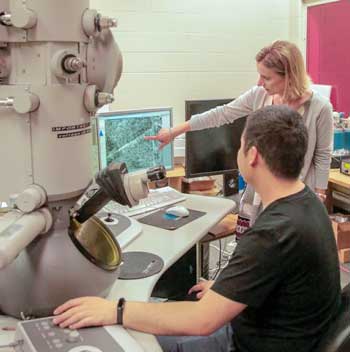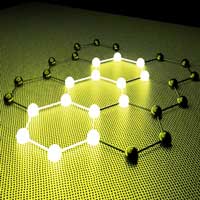 Research team shows how to manipulate gold nanoparticle temperatures with lasers.
Research team shows how to manipulate gold nanoparticle temperatures with lasers.
Friday, August 9, 2019
One linked nanoparticle's hot, the other keeps its cool
 Research team shows how to manipulate gold nanoparticle temperatures with lasers.
Research team shows how to manipulate gold nanoparticle temperatures with lasers.
Nanoparticles' movements reveal whether they can successfully target cancer
 Researchers have developed a new way to determine whether or not single drug-delivery nanoparticles will successfully hit their intended targets - by simply analyzing each nanoparticle's distinct movements in real time.
Researchers have developed a new way to determine whether or not single drug-delivery nanoparticles will successfully hit their intended targets - by simply analyzing each nanoparticle's distinct movements in real time.
Cyborg organoids offer a rare glimpse into the early stages of organ development
 Stretchable, integrated mesh nanoelectronics grow with the developing cells.
Stretchable, integrated mesh nanoelectronics grow with the developing cells.
A roadmap for flexible and green electronics
 Scientists are developing a new class of thin-film electronics, which they call 'fleco-ionics'. This comes from flexible, eco-friendly electronics, and the grand goal of the study is to find green alternatives, to reduce the explosively growing amount of electronic waste.
Scientists are developing a new class of thin-film electronics, which they call 'fleco-ionics'. This comes from flexible, eco-friendly electronics, and the grand goal of the study is to find green alternatives, to reduce the explosively growing amount of electronic waste.
Nanowire arrays could improve solar cells
 Researchers have turned to ordered metal nanowire meshes that provide high transmissivity (due to the small diameters of the nanowires), high electrical connectivity (due to the many contact points in the mesh) and use more common elements to fabricate transparent electrodes.
Researchers have turned to ordered metal nanowire meshes that provide high transmissivity (due to the small diameters of the nanowires), high electrical connectivity (due to the many contact points in the mesh) and use more common elements to fabricate transparent electrodes.
Ultrathin solar cells reach a record of nearly 20% efficiency
 Researchers have succeeded to trap sunlight efficiently in a solar cell thanks to an ultrathin absorbing layer made of 205 nm-thick GaAs on a nanostructured back mirror. With this new architecture, an efficiency of nearly 20% was obtained.
Researchers have succeeded to trap sunlight efficiently in a solar cell thanks to an ultrathin absorbing layer made of 205 nm-thick GaAs on a nanostructured back mirror. With this new architecture, an efficiency of nearly 20% was obtained.
Bending the rules: A revolutionary new way for metals to be malleable
 For nearly 100 years, scientists thought they understood everything there was to know about how metals bend. They were wrong.
For nearly 100 years, scientists thought they understood everything there was to know about how metals bend. They were wrong.
Controlling the shape-shifting skeletons of cells
 In studying the dynamic skeletons that cells use to move, researchers develop a new tool for manipulating chemistry and biology.
In studying the dynamic skeletons that cells use to move, researchers develop a new tool for manipulating chemistry and biology.
Innovative technique to synthesise advanced graphene-based nanocomposites
 Green and straightforward process for the synthesis of graphene-based nanomaterials.
Green and straightforward process for the synthesis of graphene-based nanomaterials.
Making chiral structures from achiral building blocks
 Triangular molecules on a silver surface can form different chiral structures depending on how densely they are placed on the surface.
Triangular molecules on a silver surface can form different chiral structures depending on how densely they are placed on the surface.
Subscribe to:
Comments (Atom)
